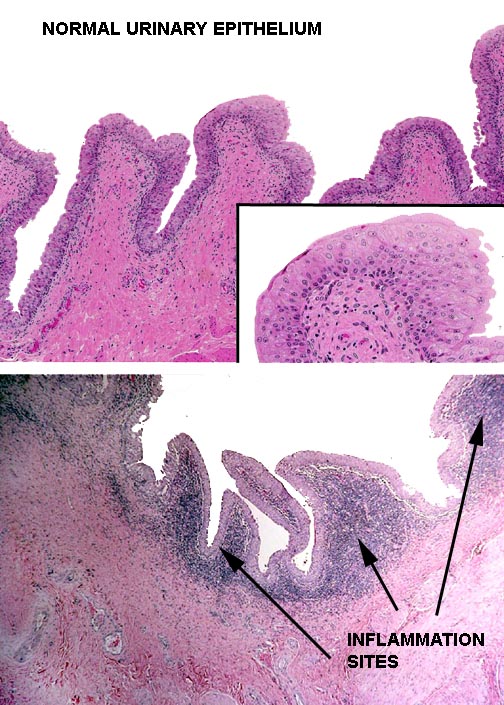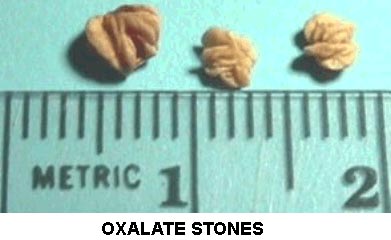DISCUSSION
Urolithiasis (mineral concretions in the urinary tract) is a common problem in cats. The stones are of several different types, of which struvite is the most common.
It's believed that these concretions come about when the dissolved minerals of which they're composed reach a point of supersaturation, and precipitate around a crystallization nucleus. Anything that increases the concentration and/or alters the conditions in the tract can trigger this process: excessive levels of calcium, magnesium, or other minerals in the diet; inappropriate changes in urine pH, or dehydration and lowered urine output.
 Cats who get little exercise often decrease water intake, predisposing them to stone formation. Some high-protein dry cat foods have been implicated as causing stones, but this is a matter of debate.
Cats who get little exercise often decrease water intake, predisposing them to stone formation. Some high-protein dry cat foods have been implicated as causing stones, but this is a matter of debate.  There is no doubt that diets too rich in stone-forming (petrogenic) substances, especially magnesium, are of concern. Cats that habitually eat plants may become overloaded with oxalates, which also are petrogenic.
There is no doubt that diets too rich in stone-forming (petrogenic) substances, especially magnesium, are of concern. Cats that habitually eat plants may become overloaded with oxalates, which also are petrogenic.
Histologically, the bladder's lining can be seen to be injured. The urinary epithelium is fairly friable, and having rocks roll around in your bladder or lodge in your urethra is more or less a sure-fire way to injure it. The breaching of the epithelium to mechanical injury leads to inflammation (left). The "tight" nature of the urinary epithelium prevents toxic or hypertonic materials from gaining access to the intercellular compartment: compromising it may cause moment of water into the bladder by osmosis, leading to dehydration. If the inflammation heals with scarring, a stricture may form that in turn serves as a place where future stones may lodge. Stones smaller than 3.0 mm size may not be visible on radiographs, and not all stones are radio-opaque.
Obviously the most significant danger here is of a urinary tract obstruction, which can have serious—occasionally fatal—consequences. An obstruction can cause hydronephrosis or hydroureter: back pressure causes dilation of the upper ureters and/or renal pelvis, or the kidney itself. Hydrostatic back pressure will slow filtration, and compression of the nephron tubules and glomeruli lead to necrosis and loss of functional units. This of course has the consequence of impairing clearance of potentially hazardous  materials that would normally be voided in the urine. A substantial obstruction is heralded by anorexia, dehydration, lethargy, and depression: a complete obstruction will eventually lead to coma and death from toxemia. The very large reserve capacity of the kidneys means that often a problem goes undetected until two-thirds of the renal parenchyma is lost, or unless both ureters become obstructed, which is an emergency situation.
materials that would normally be voided in the urine. A substantial obstruction is heralded by anorexia, dehydration, lethargy, and depression: a complete obstruction will eventually lead to coma and death from toxemia. The very large reserve capacity of the kidneys means that often a problem goes undetected until two-thirds of the renal parenchyma is lost, or unless both ureters become obstructed, which is an emergency situation.
In queens a urinary obstruction predisposes to urinary tract infections, as the urine is a fine culture medium  and any bacteria that should be voided will be retained. Blockage is more likely to occur in toms than in queens because of differences in the anatomy of the urinary tracts. If the obstruction is in the urethra (as it usually is in toms) the bladder may rupture; and the cat will be in severe pain.
and any bacteria that should be voided will be retained. Blockage is more likely to occur in toms than in queens because of differences in the anatomy of the urinary tracts. If the obstruction is in the urethra (as it usually is in toms) the bladder may rupture; and the cat will be in severe pain.
Treatments vary with severity of the symptoms and size of the stones: large ones may have to be removed surgically, the small stones commonly found in cats often can be dissolved by changing the diet. Avoiding high levels of calcium and other petrogenic substances is important. The various manufacturers of pet foods make special low-magnesium diets as a means to prevent stone formation, and having plenty of fresh water available is important: many cats won't drink water that has been standing for a long time.
References:
Merck Veterinary Manual (On-Line Edition).
 Cats who get little exercise often decrease water intake, predisposing them to stone formation. Some high-protein dry cat foods have been implicated as causing stones, but this is a matter of debate.
Cats who get little exercise often decrease water intake, predisposing them to stone formation. Some high-protein dry cat foods have been implicated as causing stones, but this is a matter of debate.  There is no doubt that diets too rich in stone-forming (petrogenic) substances, especially magnesium, are of concern. Cats that habitually eat plants may become overloaded with oxalates, which also are petrogenic.
There is no doubt that diets too rich in stone-forming (petrogenic) substances, especially magnesium, are of concern. Cats that habitually eat plants may become overloaded with oxalates, which also are petrogenic.  materials that would normally be voided in the urine. A substantial obstruction is heralded by anorexia, dehydration, lethargy, and depression: a complete obstruction will eventually lead to coma and death from toxemia. The very large reserve capacity of the kidneys means that often a problem goes undetected until two-thirds of the renal parenchyma is lost, or unless both ureters become obstructed, which is an emergency situation.
materials that would normally be voided in the urine. A substantial obstruction is heralded by anorexia, dehydration, lethargy, and depression: a complete obstruction will eventually lead to coma and death from toxemia. The very large reserve capacity of the kidneys means that often a problem goes undetected until two-thirds of the renal parenchyma is lost, or unless both ureters become obstructed, which is an emergency situation.  and any bacteria that should be voided will be retained. Blockage is more likely to occur in toms than in queens because of differences in the anatomy of the urinary tracts. If the obstruction is in the urethra (as it usually is in toms) the bladder may rupture; and the cat will be in severe pain.
and any bacteria that should be voided will be retained. Blockage is more likely to occur in toms than in queens because of differences in the anatomy of the urinary tracts. If the obstruction is in the urethra (as it usually is in toms) the bladder may rupture; and the cat will be in severe pain.